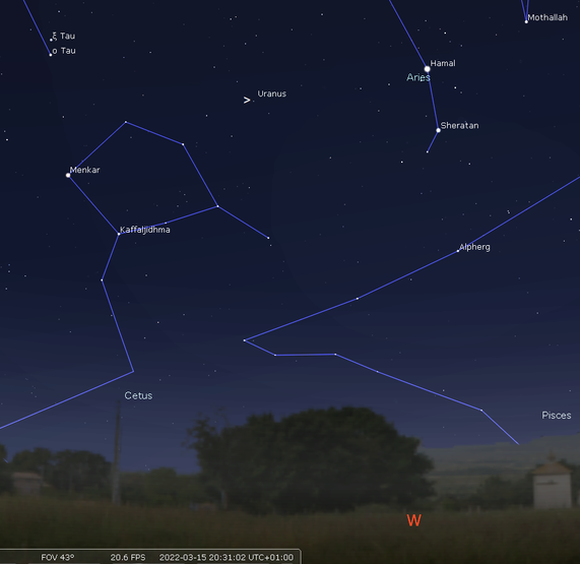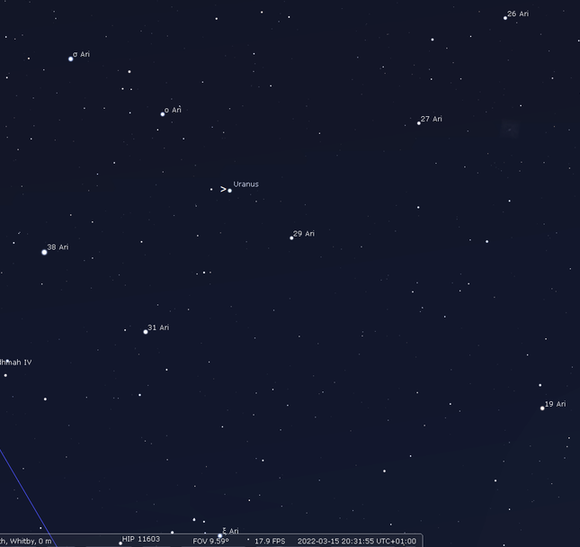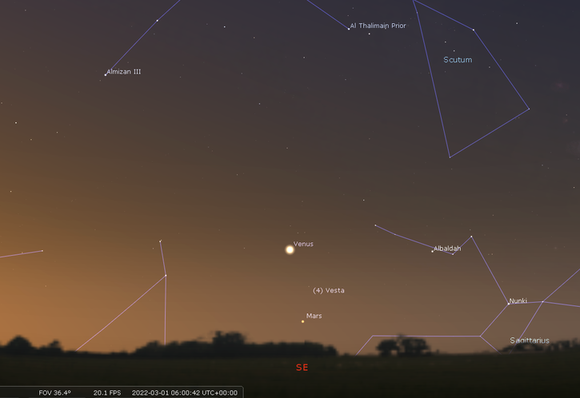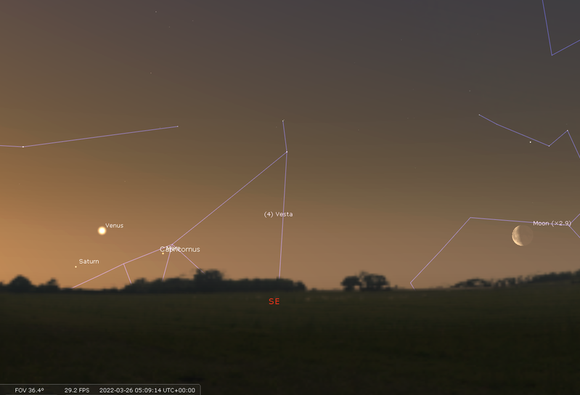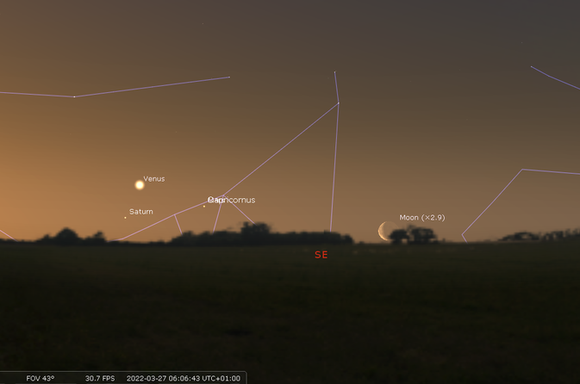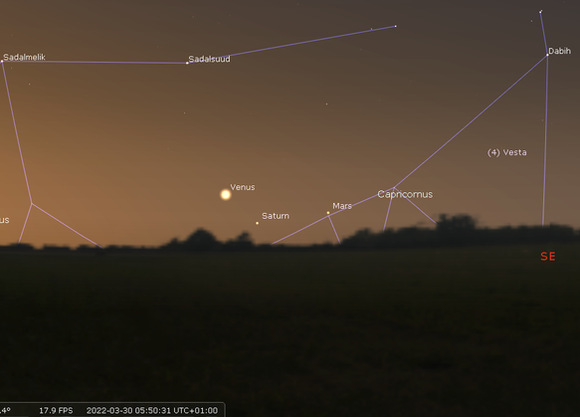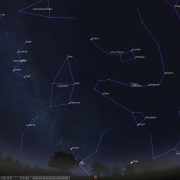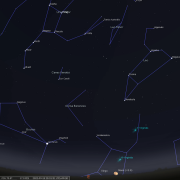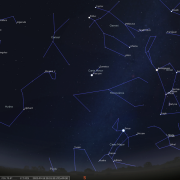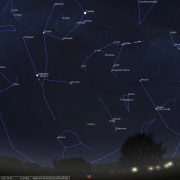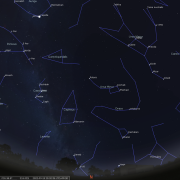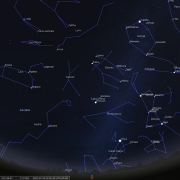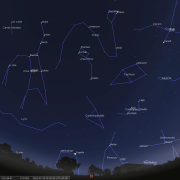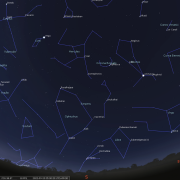In this month's Sky Notes:
Planetary Skylights - Brief
The evening sky is void of naked eye planets throughout March, Uranus being the sole planet visible, in the constellation of Aries, but only with optical aid. The dawn sky is home to three planets, with Mercury being supplanted by Saturn, returning to the sky after solar conjunction, joining Venus and Mars.
 Uranus will be the only planet visible with 'augmented eyes' (binoculars or Telescope) in the March evening sky. As darkness falls it is located in the WSW in the southern reaches of Aries, lower left of the crooked line asterism of stars marking the 'Ram' itself. Zeroing in on the exact location of Uranus can be tricky as the sky here is rather devoid of naked eye stars. Roughly speaking it lies 10 degrees below left of the chief star in Aries - Hamal. The nearest apparent stars visible through binoculars are omicron Ari and 29 Ari, both at magnitude 5.7. Uranus currently sits near the latter. At magnitude +5.85 Uranus is technically visible to the naked eye, but only from very dark locations and with good knowledge of the stellar neighbourhood. By the end of March; after the clocks go forward, Uranus will be lost to the west horizon by 21:30hrs
Uranus will be the only planet visible with 'augmented eyes' (binoculars or Telescope) in the March evening sky. As darkness falls it is located in the WSW in the southern reaches of Aries, lower left of the crooked line asterism of stars marking the 'Ram' itself. Zeroing in on the exact location of Uranus can be tricky as the sky here is rather devoid of naked eye stars. Roughly speaking it lies 10 degrees below left of the chief star in Aries - Hamal. The nearest apparent stars visible through binoculars are omicron Ari and 29 Ari, both at magnitude 5.7. Uranus currently sits near the latter. At magnitude +5.85 Uranus is technically visible to the naked eye, but only from very dark locations and with good knowledge of the stellar neighbourhood. By the end of March; after the clocks go forward, Uranus will be lost to the west horizon by 21:30hrs
Dawn Planets


 Three planets may be spotted in the dawn sky during March, though not the same three as February with Mercury being replaced by Saturn. If you are an early riser, Venus, the brilliant 'morning star' is the anchor point on which to direct your gaze due SE. It is apparent by 05:30hrs at the start of March and at magnitude -4.6 can hardly be overlooked. Through a scope the image will be heavily compromised due to unstable seeing at low altitudes, but you may be able to discern a 'waxing crescent phase' in early March growing to a 'Quarter phase' by the end of the month.
Three planets may be spotted in the dawn sky during March, though not the same three as February with Mercury being replaced by Saturn. If you are an early riser, Venus, the brilliant 'morning star' is the anchor point on which to direct your gaze due SE. It is apparent by 05:30hrs at the start of March and at magnitude -4.6 can hardly be overlooked. Through a scope the image will be heavily compromised due to unstable seeing at low altitudes, but you may be able to discern a 'waxing crescent phase' in early March growing to a 'Quarter phase' by the end of the month.
March is always a strange month for twilight observations in the UK, simply because the clocks go forward one hour towards the end of the month making evenings noticeably lighter, but mornings a little darker for a while. Always try to view 40-50mins before sunrise - 06:00hrs to 06:15hrs at the start of March and again, right at the end, but almost an hour earlier just before the clocks go forward on the 27th. Note that by the time Venus is lost in bright twilight, it has attained a similar altitude above the horizon each day, but drifted more to ESE over the course of the month.
Mars remains stubbornly close to the SE horizon located below - right of brilliant Venus. At magnitude +1.5, the Red planet resembles a star of amber hue. Careful observation will reveal Mars slowly tracking around to the ESE having started the month below Venus. Don't expect to see a great deal at all through a telescope from UK shores, Mars is still way too low and distant. It's time in the limelight will arrive, but not until the end of 2022!
Finally, Saturn creeps back into the dawn sky, visible after mid-month below left of Venus. By the end of the month Saturn has tucked itself below Venus, with Mars just off to the right, but all very low. See if you can spot a very slim crescent moon to the right of Saturn, Venus and Mars on March 26th and 27th
Meteor Watch

March continues where February left off with no recognised meteor showers of note. Even though it is a lean period for shooting stars, those that are spotted are often quite bright and it has been suggested that late January to early March; the 'fireball' season', may be a very old depleted shower of similar nature to the Geminids. Towards the end of March there are signs of activity from the various and complex Virginid radiants, but numbers remain low with 'peak activity' not reached until April. The two main radiants lie near Spica and Kappa Virginis, but typically just a few meteors per hour are recorded by an observer. True Virginids are often slow moving and long in duration, occasionally very bright (similar to Venus say) producing flares along their path. As usual the early morning hours will be most favourable.
The Spring Equinox

The date of the Spring or Vernal Equinox, and for the northern hemisphere, the start of astronomical spring, falls on March 20th this year. On this date the Sun's path on the ecliptic crosses the celestial equator on its apparent journey northwards into the sky. The orientation of the Earth at the spring or autumnal equinox is such that neither of Earth’s poles is inclined toward the Sun and all locations experience equal hours of daylight and darkness - hence the term equinox.
The Vernal Equinox is also known as the 'First point of Aries', as the Sun used to stand before the constellation of the Ram when it first crossed the celestial equator. Although still called the 'first point of Aries', today its location now resides in Pisces, a consequence of the effect known as precession; the Earth's slow wobble. Over thousands of years our ancestors noted that certain star patterns rose just before the Sun at specific times and were considered significant for this very reason. Subsequently they were able to build a picture of the apparent path of the Sun against these constellations.
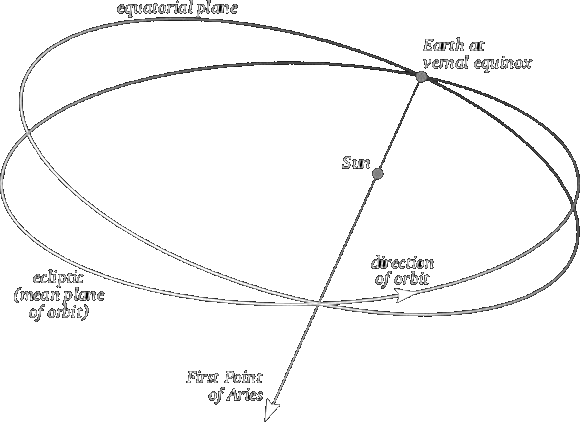
The narrow path upon which occasionally the Sun and Moon would meet giving rise to an eclipse, became known as the Ecliptic. The broader belt along which the 'wandering stars' or planets travelled was known as the Zodiac, so called because all 12 constellations located on it were associated with living creatures.

Zodiac literally means 'Band of Animals'. Libra used to be considered being part of Scopius, the claws to be precise. Ophiuchus, the serpent bearer immediately following Scorpius was instead regarded as a zodiac group. Ever since the stars of Libra were elevated in status, Ophiuchus, being surplus to requirements, was ditched, much to the relief of astrologers. If you find it difficult to remember the order of the zodiac constellations, then the following rhyme may be of use.
The Ram, the Bull, the Heavenly twins
and next the Crab the Lion shines,
The Virgin, and the Scales.
Scorpion, Archer and Sea goat,
The man who pours the water out
and Fish with glittering tails
March 2022 Sky Charts
Additional Image Credits:
- Planets and Comets where not otherwise mentioned: NASA
- Sky Charts: Stellarium Software and Starry Night Pro Plus 8
- Log in to post comments

